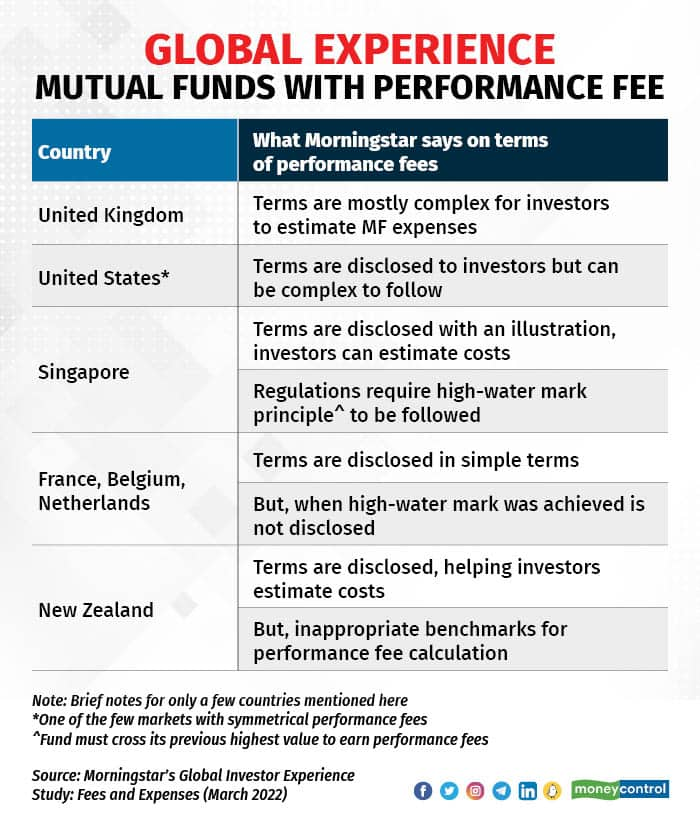



The Securities and Exchange Board of India (SEBI) is considering introducing a performance-based fee model for mutual funds (MFs) in India. The idea is to ensure that fund managers have more skin in the game. The idea of performance fees for MFs is not novel ― there are MFs in the US, the UK and other European countries, as well as in Asia and Australia that do offer such a fee model, but these are few and far between. Explaining why that is so, Feroze Azeez, Deputy Chief Executive Officer (CEO), Anand Rathi Wealth, says, “Globally, it’s not a big focus area, as it’s not easy for companies to operate mutual funds in this (performance-based fees) set-up. The revenue is uncertain whereas the costs are certain.”
Apart from that, from the investors' perspective, the complexity of how the performance fee is calculated may deter investors from opting for it. Note that the performance fee model may be one option (in addition to a fixed fee option) and not the only one to be offered to investors.
Talking about the UK market, Munish Randev, Founder & CEO, Cervin Family Office, says that performance-based fee model has not been popular for the mainstream MFs meant for retail investors. It is usually the higher-risk, concentrated portfolio kind of MF schemes that tend to offer this fee model.
In a fixed-fee model, an asset management company (AMC) charges investors a certain management fee (fixed percentage) for managing their money ― this is irrespective of the fund performance. Under a performance-based fee model, in addition to the fixed percentage fee (which is set at a lower level), there is also a performance fee. This is charged as a certain percentage of the additional return over the fund benchmark over a specific period of time.

Among the well-known AMCs that offer performance-based fee mutual funds are AllianceBernstein, BlackRock, Franklin Templeton, Invesco, JPMorgan Chase, PIMCO, and T. Rowe Price (Source: Anand Rathi Shares & Stock Brokers Research).
Also see: MC30 List of FundsHow performance-based fee models workGlobally, funds have followed either the symmetrical or the asymmetrical performance fee model, with the latter being the dominant one. Going by a Morningstar March 2022 report titled Global Investor Experience Study: Fees and Expenses, barring a few markets like the US where regulatory requirements mandate fulcrum fees (symmetrical fees), most others have asymmetrical fees.
Under a symmetrical performance fee structure, on the one hand, outperformance (say, beating the benchmark over a specified period) is rewarded, while on the other hand, underperformance is penalised. That is, the performance fees can be adjusted both upwards and downwards ― which is more in alignment with investor interest. On the other hand, with asymmetrical fees, the fund manager earns an additional fee for outperformance (or nothing additional if the target is missed), but there is no cut in performance fee for underperformance.
So, how have performance-based fee models for MFs fared globally?
Morningstar’s March 2022 report reveals a mixed picture on the country-wise experience with performance fee-based MFs. For example, according to the report, in the US and the UK, the terms of performance fees are disclosed to investors, but can be complex to understand. (See table for other countries)

Talking about funds in New Zealand, the report says that while the disclosures in fund documents can help investors estimate the cost they will incur, inappropriate benchmarks are being used to calculate performance fees. One such instance is of equity funds that use cashplus benchmarks (something that may be more appropriate for fixed income funds).
In the context of several European countries, such as France, Finland, the Netherlands and Belgium, the report notes that the terms of performance fees are clearly stated, and appropriate benchmarks are used. But, in most cases, the funds typically don’t disclose the date of when the last high-water mark (the previous high achieved by the fund that must be breached for performance fee to kick in) was reached. In the absence of that, investors cannot estimate what their MF expense will be.
Given the limited presence of performance fee-based MFs globally, it will be interesting to see how this model is introduced and implemented in the Indian MF industry. Some key points worth looking out for would be ― will it be symmetrical or asymmetrical performance fee, what is the period over which performance gets measured (say, on a yearly basis), and the minimum return that a fund must earn before performance fees becomes applicable.
Also read: Got Rs 10 lakh to invest? Kotak AMC’s Harish Krishnan shares strategy for retail investorsDiscover the latest Business News, Sensex, and Nifty updates. Obtain Personal Finance insights, tax queries, and expert opinions on Moneycontrol or download the Moneycontrol App to stay updated!
Find the best of Al News in one place, specially curated for you every weekend.
Stay on top of the latest tech trends and biggest startup news.